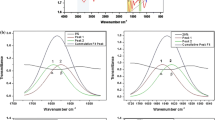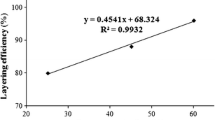Abstract
PDMS derivatives have been extensively used as coating in controlled drug delivery systems in pharmaceutical area. The major advantages of these materials are facilitation of adjustment of desired drug release patterns, improvement of film formation and storage stability. In this study PDMS-based coating systems were designed and applied to acetaminophen tablets and their release was investigated from the PDMS-coated tablet dosage form as a drug model. Thus, a water emulsion of PDMS containing tetraethoxysilane as cross-linking agent and polyvinylpyrrolidone (PVP) as channeling agent was prepared. Then, a uniform smooth thin coating of PDMS was applied on acetaminophen tablets and in vitro acetaminophen release from PDMS-coated tablets was carried out with a homemade setup. The morphology of the coated surfaces was studied by SEM technique. The effect of PVP on the mechanical properties of PDMS film was investigated by dynamic mechanical analysis. It was found that, PVP increased the mechanical properties of PDMS. Compounding of polyethylene glycol (PEG) with PVP (1:1) as channeling agents was also studied and compared with PVPs-containing samples. Despite more channeling agent content in PEG–PVP samples, the drug release percentage was decreased.






Similar content being viewed by others
References
Siepmann F, Siepmann J, Walther M, MacRae RJ, Bodmeier R (2008) Polymer blends for controlled release coatings. J Control Release 125:1–15
McCarthy DW, Mark JE (1998) Poly(dimethylsiloxane) elastomers from aqueous emulsions: I. preparations, and characterization of the curing and aging processes. Rubber Chem Technol 71:906–927
Fu Y, Kao WJ (2010) Drug release kinetics and transport mechanisms of non-degradable and degradable polymeric delivery systems. Expert Opin Drug Deliv 7:429–444
Rahimi A, Mashak A (2013) A review on rubbers in medicine: natural silicone and polyurethane rubbers. Plast Rubber Compos 42:223–230
Mashak A (2008) In vitro drug release from silicone rubber–polyacrylamide composite. Silicone Chem 3:295–301
Mashak A, Rahimi A (2009) Silicone polymers in controlled drug delivery systems: a review. Iran Polym J 18:279–295
Li LC, Peck GE (1989) Water based silicone elastomer controlled release tablet film coating 1: free film evaluation. Drug Dev Ind Pharm 15:65–95
Dahl TC, Sue IT (1992) Mechanisms to control drug release from pellets coated with a silicone elastomer aqueous dispersion. Pharm Res 9:398–405
Nahrup JS, Gao ZM, Mark JE, Sakr A (2004) Poly(dimethylsiloxane) coatings for controlled drug release polymer modifications. Int J Pharm 270:199–208
Garekani HA, Sadeghi F, Ghazi A (2003) Increasing the aqueous solubility of acetaminophen in the presence of polyvinylpyrrolidone and investigation of the mechanisms involved. Drug Dev Int Pharm 29:173–179
Gao Z, Nahrup JS, Mark JE, Sakr A (2005) Poly(dimethylsiloxane) coatings for controlled drug release. III. Drug release profiles and swelling properties of the free-standing films. J Appl Polym Sci 96:494–501
Panou AI, Papadokostaki KG, Tarantili PA, Sanopoulou M (2013) Effect of hydrophilic inclusions on PDMS cross-linking reaction and its interrelation with mechanical and water sorption properties of cured films. Eur Poly J 49:1083–1810
Pandey P, Turton R, Joshi N, Hammerman E, Ergun J (2006) Scale-up of a pan-coating process. AAPS Pharm SciTec 7:125–132http://www.sciencedirect.com/science/article/pii/S0014305713001730 - af005
Mashak A, Taghizadeh SM (2006) In vitro progesterone release from γ-irradiated cross-linked polydimethylsiloxane. Radiat Phys Chem 75:229–235
Carlberg M, Colombini D, Maurer FHJ (2004) Ethylene–propylene–rubber (EPR)/polydimethylsiloxane (PDMS) binary polymer blends: morphology and viscoelastic properties. Appl Polym Sci 94:2240–2249
Feldstein MM, Roos A, Chevallier C, Creton C, Dormidontovac EE (2003) Relation of glass transition temperature to the hydrogen bonding degree and energy in poly(N-vinyl pyrrolidone) blends with hydroxyl-containing plasticizers: 3. Analysis of two glass transition temperatures featured for PVP solutions in liquid poly(ethylene glycol). Polymer 44:1819–1834
Acknowledgments
The financial support from Iran National Science Foundation (Grant No. 87041557) is gratefully acknowledged.
Author information
Authors and Affiliations
Corresponding author
Rights and permissions
About this article
Cite this article
Soroory, H., Mashak, A. & Rahimi, A. Application of PDMS-based coating in drug delivery systems using PVP as channeling agent. Iran Polym J 22, 791–797 (2013). https://doi.org/10.1007/s13726-013-0178-7
Received:
Accepted:
Published:
Issue Date:
DOI: https://doi.org/10.1007/s13726-013-0178-7




